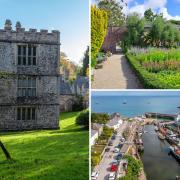The tranquil Port Gaverne in North Cornwall is a stone's throw from Port Isaac - home to Doc Martin
Cornwall is no slouch when it comes to coastal beauties, but for BRU ZANELLI you would need to go some way to beat the unspoilt glories of Port Gaverne
In a land of legends, hamlets and coves of stunning beauty, down on the spectacular north coast, just below Port Isaac, hides one such treasure: Port Gaverne, arguably Cornwall’s quaintest cove nestling in beneath the cliffs.
To find it on foot, the visitor should take the cliff road out of Port Isaac. The path is newly re-formed and easy to negotiate, with the shimmering turquoise sea to the left and newly built holiday homes on the right. Enjoy the breathtaking views across Port Isaac Bay and out to sea where dolphins are often seen leaping up through the waves to smile at the watching tourists. Having taken your photos, walk on and soon you will traverse the open aired, two-tiered car park, usually packed tight, unless you visit out of season. Pause a while to admire the diamonds skimming over the water below, then continue, following the road ahead.
There appears to be little in Port Gaverne, other than some holiday lets, a few determined residents (twenty at the last count), and a small hotel, which has been there for four centuries in one form or another.
You will need to stoop to avoid low hanging branches filled with an abundance of floral delights, while your feet tread the well worn path, past the sign of welcome proudly proclaiming Port Gaverne. Continue down the steep hill into the enticing hamlet below where the scattering of white washed cottages and buildings poised around the tiny bay, wait, sparkling beneath the sun, resembling a painting by local artist, the late Frank McNichol.
The handkerchief-sized beach is shingle and at low tide it is home to a small selection of moored boats and seeing it for the first time never fails to bring forth a gasp of delight. Port Gaverne really is picture postcard perfect!
The hill separating Port Gaverne from the busier Port Isaac, could be carved out of ancient stone like the vertical cliff wall which supports cottages and hotels up high, all with views to die for. But it is the miniscule cove below which attracts the visitors. So why do the visitors come?
There appears to be little in Port Gaverne, other than some holiday lets, a few determined residents (twenty at the last count), and a small hotel, which has been there for four centuries in one form or another.
Yet the beauty and tranquillity of the inlet is addictive and once visited, draws one back time and time again.
One such visitor, a lady in her sixties, resting on a bench overlooking the beach, explained: I’ve been coming here for 35 years. We found it by chance and stayed for a week. We’ve been coming back every year since, sometimes more than once in a year.
Back then we would stay at the hotel - when it was owned by Midge and Freddie Ross – God rest them. It was a family atmosphere. Everyone knew everyone by name; more like a house party. These days we prefer to rent a cottage.’
So what is the attraction? For a week or two we can live out a dream. The sea, wildlife, the flora …’ She paused to greet a passer by. And everyone is so friendly’.
Her husband, a keen bird watcher, was nowhere to be seen. Oh he’ll be up on the cliffs’ she said I better go find him – I’ve prepared a picnic.’
Down on the beach, considered the safest beach in North Cornwall, and in the care of the National Trust (as is much of Port Gaverne), some youngsters play in the rockpools, while an old fisherman works on his boat. It is like a scene from another age.
Up ahead, some smooth rocks, called Teaques Pit, provide a natural sunbathing platform at the water’s edge. They can be reached via the beach at low tide, or across the small Frank McNichol Bridge, a memorial to the aforementioned local artist.
Over the years, Cornwall has spawned numerous talented artists and writers, and Port Gaverne proudly lays claim to one of the best. Originally from the Isle of Man, Frank McNichol travelled the world extensively before settling in Port Gaverne, in 1966. A much loved local’, he was often to be seen in the village sketching, wearing his trademark hat, or sitting in the pub in his favourite seat beneath the window – where he was always ready for a chat.
Frank passed away in May 2003, aged 92 but his work can still be admired in Port Gaverne; the mural that adorns the front façade of the local inn, is one of his best loved paintings and postcard reproductions are on sale at the reception desk, while his three dimensional diorama of Port Issac can be viewed in the upstairs lounge.
Although now a favourite holiday destination, Port Gaverne was once the main exit route for the vast amounts of slate mined at nearby Delabole, until in the 1890s when the railway arrived at Delabole. But it remained a busy fishing village until the pilchards disappeared, forcing fisherfolk to move on and seek work elsewhere. The fish cellars – many of them now holiday cottages – serve as a reminder of those long gone days.
When the steam engines of the Great Western and Southern Railways started to bring visitors from all over Britain to this beautiful and tranquil haven, Port Gaverne, like many parts of Cornwall, was forced to embrace tourism, instead of fishing, as its livelihood.
What is not commonly known is that during World War II, Port Gaverne, became home to many evacuees. Stories are still shared by the old timers’ locally about how the fish cellars were converted into homes for the children, along with the now empty Headlands Hotel, up on the cliffs. Some of those children’ still live in the area.
During the season, on balmy summer evenings when visitors step outside the pub to watch the breathtaking sunset over the bay, memories of the past linger in the air, only slightly disturbed by the youthful shouts and laughter of the emmets’ – the tourists - who have discovered this very special Cornish gem.
But memories of the past are very much what has shaped the present Port Gaverne, one of Cornwall’s best kept secrets.
This feature first appeared in Cornwall Life March 2015



























